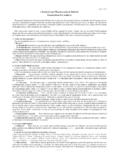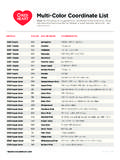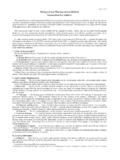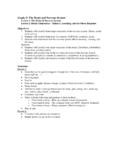Transcription of Instructions for Authors (2018) - Pharm
1 (May 1, 2016). chemical and pharmaceutical bulletin Instructions for Authors The journal chemical and pharmaceutical bulletin aims to advance pharmaceutical sciences worldwide and will accept original, innovative submissions in English from both members and nonmembers of the pharmaceutical Society of Japan. The submissions should be previously unpublished and not being considered for publication elsewhere. All listed Authors must agree with the contents of the paper and give their consent for its submission. Only manuscripts written in clear, concise English will be accepted for review. Authors who are not native English speakers should note that only manuscripts checked and edited by a native English speaker with sufficient scientific knowledge will be accept- ed. English judged to be inadequate by the Editorial Board will be edited at the Authors ' expense before publication.
2 TYPES OF MANUSCRIPT. The Journal publishes Reviews, Communications, Regular Articles, and Notes. 1. Reviews: (1) Regular Reviews: Reviewing scientific discoveries including the recent results of the author(s). (2) Invited Reviews: Submitted by invitation from the Editorial Board, and encompass recent important scientific discoveries. 2. Communications: Communications should contain new and important information that would be of interest to readers of the Journal, making urgent publication is desirable. An explanatory statement is required for urgent publication. In general, a Communi- cation should not exceed 2000 words (approximately 4 printed pages). 3. Regular Articles: The manuscript being submitted must consist of original research performed by the Authors and the research must include new information that is of significance.
3 4. Notes: Papers containing new facts and important data derived from incomplete or partial studies may be suitable as a Note. In general, a Note should not exceed 2000 words (approximately 4 printed pages).. MANUSCRIPT PREPARATION. 1. Cover letter The cover letter should include information on the corresponding author (the corresponding author's name, affiliation and address, telephone/fax numbers, and e-mail address). As for Communications, please indicate in the cover letter the reason why the manuscript should be treated as a Communication. 2. Manuscript The text, figures, and tables should be submitted as three separate files or one file. These are automatically in- corporated into a single PDF that the system creates for review. Please use Times New Roman font in 12-point size for Word files.
4 All files should have a page setup for A4-sized (210 mm wide 297 mm high) paper when printed. Tables can be displayed horizon- tally if necessary. (1) Title page The title page (page 1) should start with the journal name (Chem. Pharm . Bull.) and type of manuscript (Communication, Regular Article, etc.). This should be followed by the title, name(s) of the author(s), affiliation(s), and mailing address(es). Please indicate the corresponding author's e-mail address in the footnote. An asterisk (*) should be added to the right of the corresponding author's name. Use a dagger ( ) to the right of a name to indicate that the present affiliation of an author is differ- ent to that of when the paper was written. In the footnotes, show the author's current affiliation and address.
5 (2) Summary and Keywords Page 2 should contain a summary no longer than 250 words as well as 3 to 6 descriptive keywords, listed in decreasing order of importance. The first 3 keywords must be independent, as they will be used in a keyword combination in the index (within 80 characters). Abbreviations should not be used as keywords. (3) Main text The text, acknowledgments, conflict of interest, and references should be presented in this order. 3. Graphical Abstracts The graphical abstract, which Authors must supply at the time the manuscript is first submitted, is presented in the Table of Contents so that readers can grasp the outline of the manuscript at a glance. Graphical abstracts should con- sist of carefully drawn figures ( chemical structures, charts, graphs, images, or other informative illustrations) that show the most striking feature of the article in a pictorial form.
6 Appropriate text may be included in the illustration. The illustration should be no larger than 100 mm wide 40 mm high. The use of color to enhance the value and quality of the graphic is encouraged since they will be printed in color. 4. Supplementary materials If an article has some supplementary materials, the author(s) should state it between Conflict of Interest and References: The online version of this article contains supplementary materials.. 5. Additional information for review Other data necessary for review may be submitted as additional information. Addition- al information will not be published in the journal.. MANUSCRIPT FORM. 1. Affiliations When there are two or more Authors and they belong to more than one affiliation, the connection between each author and his or her affiliation should be indicated by italicized superscripts a, b, c placed after each author's name and before each affiliation.
7 Examples for describing affiliations and mailing addresses: a Department of Molecular Biology, Graduate School of pharmaceutical Sciences, Hokkaido University; Kita 12, Nishi 6, Kita-ku, Sapporo 060 0812, Japan: b Biomedical Research Institute, National Institute of Advanced Industrial Science and Technology (AIST); Central 6, 1 1 1 Higashi, Tsukuba, Ibaraki 350 8566, Japan: and c Department of pharmaceutical Services, Hiroshima University Hospital; 1 2 3 Kasumi, Minami-ku, Hiroshima 734-8551, Japan. 2. Abbreviations Abbreviations must be spelled out in full at their initial appearance each in the summary and the main text, followed by the abbreviation in parentheses. Thereafter, the abbreviation only may be used. Please limit to a minimum the use of ab- breviations in the title.
8 However, the following need not be defined: ADP (adenosine 5 -diphosphate), AIDS (acquired immunodefi- 1 . ciency syndrome), AMP (adenosine 5 -monophosphate or adenylic acid), ANOVA (analysis of variance), ATP (adenosine 5 -triphos- phate), cAMP (adenosine 3 ,5 -cyclic monophosphate), cDNA (complementary DNA), CoA (coenzyme A), CYP (cytochrome P450), DNA (deoxyribonucleic acid), ED50 (50% effective dose), ESR (electron spin resonance), FAB-MS (fast atom bombardment mass spectrometry), FAD (flavin adenine dinucleotide), GC-MS (gas chromatography-mass spectrometry), GLC (gas-liquid chromatogra- phy), GMP (guanosine 5 -monophosphate), HPLC (high-performance liquid chromatography, high-pressure liquid chromatography), IC50 (inhibitory concentration, 50%), IR (infrared), LC (liquid chromatography), LC/MS (liquid chromatography/mass spectrome- try), LD50 (50% lethal dose)
9 , mRNA (messenger RNA), MS (mass spectrum), NMR (nuclear magnetic resonance), OTC (over the counter), PCR (polymerase chain reaction), QOL (quality of life), RNA (ribonucleic acid), RT-PCR (reverse transcription polymerase chain reaction), TLC (thin-layer chromatography), tRNA (transfer RNA), UV (ultraviolet), WHO (World Health Organization). 3. Units The following units should be used: length (m, cm, mm, m, nm, ), mass (kg, g, mg, g, ng, pg, mol, mmol, mol), volume (L, mL, L), time (s, min, h, d), temperature ( C, K), radiation (Bq, dpm, Gy, Sv), and concentration (m, mm, mol/L, mmol/L, mg/mL, g/mL, %, % (v/v), % (w/v), ppm, ppb). 4. Spectral and Elemental Analysis Data Please report spectral and elemental analysis data in the following format. 1H- NMR (CDCl3) : (3H, d, J= Hz), (1H, q, J= Hz), (1H, m).
10 13C-NMR (CDCl3) : (q), (d), (s). IR. (KBr) cm 1: 1720, 1050, 910. UV max (EtOH) nm ( ): 241 (10860), 288 (9380). UV max (H2O) nm (log ): 280 ( ). FAB-MS m/z: (Calcd for C18H20O6: ). MS m/z: 332 (M+), 180, 168. [ ]D23 (c= , MeOH). Anal. Calcd for C19H21NO3: C, ; H, ; N, Found: C, ; H, ; N, 5. Nomenclature The nomenclature used for chemical compounds shall be in accordance with the nomenclature rules formu- lated by IUPAC. Alternatively, naming may conform to the nomenclature in the index of chemical Abstracts or the Ring Index. 6. References and Notes References include articles published in journals, books, on the Internet, and others (technical re- ports, patents, lectures, etc.). References other than those indicated above should be described in the text. References should be num- bered consecutively according to the order of citation in the text (one Arabic number should be assigned to each reference or note).



